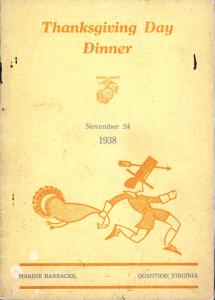What do you think about when you think of Thanksgiving? The food-focused holiday probably comes to mind is a turkey dinner, a presidential turkey pardoning and a bunch of turkeys all waiting in line for Black Friday sales. But is that what Thanksgiving is truly about?

Photograph from USMC Archives in Wikimedia Commons
In elementary school, many people may have been taught that the first Thanksgiving was about the American Indians providing a feast for the Pilgrims. The two groups sat down, said a prayer and dug in — instantly creating this November holiday.
However, this depiction of the Thanksgiving Day holiday isn’t the whole story.
For starters, the actual definition of Thanksgiving Day, as stated in the American People’s Encyclopedia, is thus: “Thanksgiving Day, the annual fall festival in the United States set aside for giving thanks to God for the blessings of the past year. It is celebrated with church services and family gatherings as one of the great American feast days. The date is the fourth Thursday in November.”
The encyclopedia continues to explain the first “Thanksgiving proclamation in America” — where the Pilgrim hunters “provided a number of wild turkeys” and the American Indians brought venison. But we have to get into the meat, so to speak, of the article to realize that this as an example rather than a definition.

Photograph from Steindy in Wikimedia Commons
In other words, an “annual fall festival for giving thanks to God” hardly resembles the modern perception. But it seems that the definition is apt for past Thanksgivings.
Though it wasn’t recognized annually and with an exact date until the Civil War, Thanksgiving Day was practiced in times when blessings were being counted most.
After the American Revolution, the holiday was recommended in 1784 by Congress because of the exhaustive war for independence. In 1815, after the War of 1812, President Madison set aside a day for Thanksgiving in November. Sparking a custom of proclamations by governors, his act kept the custom alive for nearly 50 years. Finally, in 1863 at the behest of lifelong campaigner Mrs. Sara J. Hale, Abraham Lincoln issued a national Thanksgiving proclamation which set the official date as the fourth Thursday in November.
The transition to what we now know as Thanksgiving Day started with Franklin D. Roosevelt. Though Lincoln had proclaimed the fourth Thursday of the month as Thanksgiving, the custom with the succeeding presidents was the last Thursday. Roosevelt, according to Archives.org, changed it back to the second to last Thursday in November because he was “concerned that the shortened Christmas shopping season might dampen the economic recovery.”
However, this created a rift in the states who didn’t want to change the old custom. So Congress enacted a resolution in 1941 to make the fourth Thursday of November the official date of Thanksgiving. The resolution also gave the day its name and made it “a legal public holiday to all intents and purposes.”
From then on, it seems that the definition of Thanksgiving Day has become more synonymous with awkward dinner conversations, Black Friday stampedes, and four day weekends. The “thanks” in Thanksgiving Day was lost in the gravy. The blessings that were once cherished now sit in the liner next to the Natural Resources Defence Council’s estimated 203 million pounds of wasted turkey we could hardly stomach.
One of our previous presidents recognized this and had some advice for all of us in his Proclamation of Thanksgiving Day almost 44 years to the date: “Today, in an age of too much fashionable despair, the world more than ever needs to hear America’s perennial harvest message: “Take heart, give thanks. To see clearly about us is to rejoice; and to rejoice is to worship the Father; and to worship Him is to receive more blessings still.”
In conclusion be grateful for what you have, rejoice in it, and praise God for the blessings bestowed. Funny how it took President Nixon to state the definition of Thanksgiving. Granted, he said it after being reelected with 521 electoral votes.
So, after this little history lesson, I’d like to ask: What are you grateful for this Thanksgiving?




